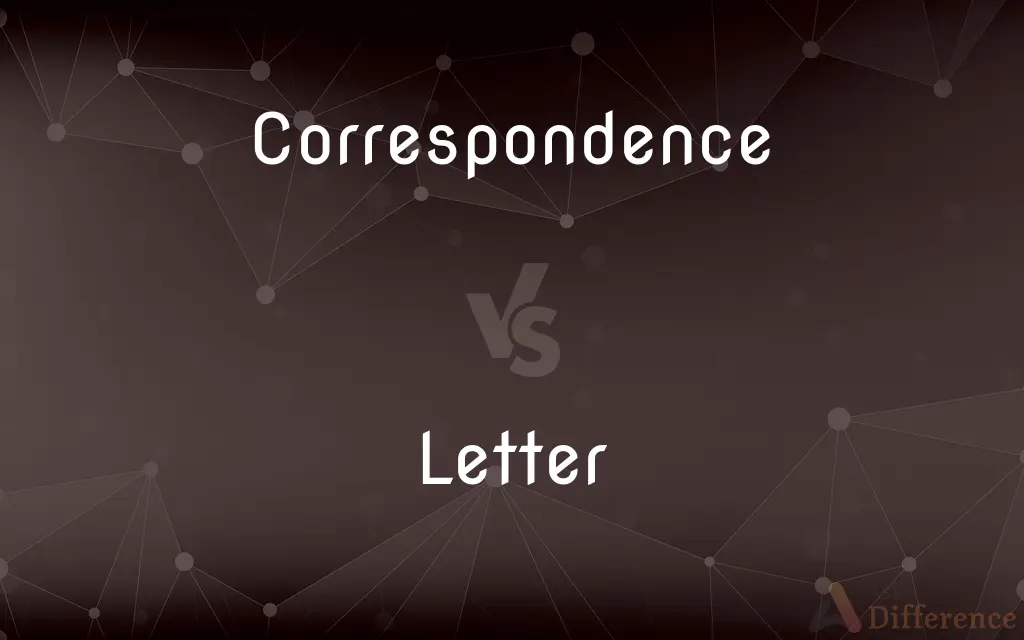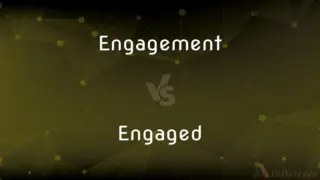Correspondence vs. Letter — What's the Difference?
Edited by Tayyaba Rehman — By Urooj Arif — Updated on March 24, 2024
Correspondence encompasses all forms of communication exchanged, while a letter is a specific, often formal, written message.

Difference Between Correspondence and Letter
Table of Contents
ADVERTISEMENT
Key Differences
Correspondence refers broadly to the exchange of messages between parties, encompassing various forms of communication, including letters, emails, and memos. On the other hand, a letter is a specific type of correspondence that is typically written, addressed, and sent to a particular recipient or organization.
While letters are traditionally physical documents sent via postal services, correspondence can take many forms, including digital communications like emails and social media messages. Letters, however, are often formal and follow specific conventions in layout and language.
Correspondence can be continuous and involve multiple exchanges between the same parties, facilitating ongoing communication. Whereas a letter might be a one-off communication or part of a series of letters exchanged.
The purpose of correspondence can vary widely, from personal communication and business dealings to official notifications and legal matters. Conversely, letters often serve specific purposes such as conveying congratulations, condolences, or formal requests.
In terms of content, correspondence can include a broad range of subjects and tones, from casual and informal to highly formal and structured. In contrast, letters usually adhere to a more formal tone and structure, especially in professional or official contexts.
ADVERTISEMENT
Comparison Chart
Definition
Exchange of messages between two parties
A written message addressed to a recipient
Form
Can be letters, emails, memos, etc.
Traditionally a physical document
Frequency
Can be ongoing and continuous
Often a single or finite series of exchanges
Purpose
Varied, from personal to legal matters
Often specific, like requests or notifications
Tone and Content
Ranges from casual to formal
Usually maintains a formal structure and tone
Compare with Definitions
Correspondence
Exchange of information.
The correspondence between the two companies lasted several months.
Letter
Written message.
She wrote a letter to express her gratitude.
Correspondence
Broad in form.
His correspondence included emails, letters, and even fax messages.
Letter
Often one-off.
He sent a letter of resignation to his employer.
Correspondence
Can be ongoing.
Ongoing correspondence between the pen pals developed into a strong friendship.
Letter
Specific purpose.
The official letter served as a formal invitation.
Correspondence
Ranges in tone.
Their correspondence started formally but became more casual over time.
Letter
Formal structure.
The business letter followed a strict format.
Correspondence
Varied purposes.
The lawyer's correspondence covered everything from advice to legal notices.
Letter
Physical form.
The letter arrived in the morning mail.
Correspondence
The act, fact, or state of agreeing or conforming
The correspondence of the witness's statement with the known facts suggests that he is telling the truth.
Letter
A character representing one or more of the sounds used in speech; any of the symbols of an alphabet
A capital letter
Correspondence
Communication by the exchange of letters, emails, or other forms of written messages.
Letter
A written, typed, or printed communication, sent in an envelope by post or messenger
He sent a letter to Mrs Falconer
Correspondence
The messages sent or received.
Letter
The precise terms of a statement or requirement; the strict verbal interpretation
We must keep the spirit of the law as well as the letter
The officer in the incident got in trouble for following the letter of the law
Correspondence
Mutual communication or discourse:
Letter
Literature
The world of letters
Correspondence
Friendly discussion.
Letter
A style of typeface.
Correspondence
(uncountable) Reciprocal exchange of civilities, especially conversation between persons by means of letters.
Letter
Inscribe letters or writing on
Her name was lettered in gold
Correspondence
(uncountable) Newspaper or news stories.
Letter
Be given a school or college initial as a mark of proficiency in sport
In high school she lettered in soccer, basketball and softball
Correspondence
Postal or other written communications.
Letter
A written symbol or character representing a speech sound and being a component of an alphabet.
Correspondence
Congruity or similarity between different things, people, etc:
Letter
A written symbol or character used in the graphemic representation of a word, such as the h in Thames. See Note at Thames.
Correspondence
(countable) An agreement of situations or objects with an expected outcome.
Letter
A written or printed communication directed to a person or organization.
Correspondence
A relation.
Letter
Often letters A certified document granting rights to its bearer.
Correspondence
A similarity between physical and spiritual things e.g. light to wisdom, or warmth to love
Letter
Literal meaning
Had to adhere to the letter of the law.
Correspondence
Friendly intercourse; reciprocal exchange of civilities; especially, intercourse between persons by means of letters.
Holding also good correspondence with the other great men in the state.
To facilitate correspondence between one part of London and another, was not originally one of the objects of the post office.
Letter
Literary culture; belles-lettres.
Correspondence
The letters which pass between correspondents.
Letter
Learning or knowledge, especially of literature.
Correspondence
Mutual adaptation, relation, or agreement, of one thing to another; agreement; congruity; fitness; relation.
Letter
Literature or writing as a profession.
Correspondence
Communication by the exchange of letters
Letter
A piece of type that prints a single character.
Correspondence
Compatibility of observations;
There was no agreement between theory and measurement
The results of two tests were in correspondence
Letter
A specific style of type.
Correspondence
The relation of correspondence in degree or size or amount
Letter
The characters in one style of type.
Correspondence
A function such that for every element of one set there is a unique element of another set
Letter
An emblem in the shape of the initial of a school awarded for outstanding performance, especially in varsity athletics.
Correspondence
Communication by exchange of letters
Letter
To write letters on
Lettered the paper.
Correspondence
(mathematics) an attribute of a shape or relation; exact correspondence of form on opposite sides of a dividing line or plane
Letter
To write in letters
Lettered our name on the mailbox.
Correspondence
Similarity by virtue of correspondence
Letter
To write or form letters.
Letter
To earn a school letter, as for outstanding athletic achievement
She lettered in three collegiate sports.
Letter
A symbol in an alphabet.
There are twenty-six letters in the English alphabet.
Letter
A written or printed communication, generally longer and more formal than a note.
I wrote a letter to my sister about my life.
Letter
The literal meaning of something, as distinguished from its intended and remoter meaning (the spirit).
Letter
Literature.
Benjamin Franklin was multiskilled – a scientist, politician and a man of letters.
Letter
(law) A division unit of a piece of law marked by a letter of the alphabet.
Letter (b) constitutes an exception to this provision.
Letter
A size of paper, 8½ in × 11 in (215.9 mm × 279.4 mm, US paper sizes rounded to the nearest 5 mm).
Letter
A size of paper, 215 mm × 280 mm.
Letter
Clipping of varsity letter
Letter
A single type; type, collectively; a style of type.
Letter
(archaic) One who retards or hinders.
Letter
(transitive) To print, inscribe, or paint letters on something.
Letter
To earn a varsity letter (award).
Letter
One who lets or permits; one who lets anything for hire.
Letter
One who retards or hinders.
Letter
A mark or character used as the representative of a sound, or of an articulation of the human organs of speech; a first element of written language.
And a superscription also was written over him in letters of Greek, and Latin, and Hebrew.
Letter
A written or printed communication; a message expressed in intelligible characters on something adapted to conveyance, as paper, parchment, etc.; an epistle.
The style of letters ought to be free, easy, and natural.
Letter
A writing; an inscription.
None could expound what this letter meant.
Letter
Verbal expression; literal statement or meaning; exact signification or requirement.
We must observe the letter of the law, without doing violence to the reason of the law and the intention of the lawgiver.
I broke the letter of it to keep the sense.
Letter
A single type; type, collectively; a style of type.
Under these buildings . . . was the king's printing house, and that famous letter so much esteemed.
Letter
Learning; erudition; as, a man of letters.
Letter
A letter; an epistle.
Letter
A telegram longer than an ordinary message sent at rates lower than the standard message rate in consideration of its being sent and delivered subject to priority in service of regular messages. Such telegrams are called by the Western Union Company day letters, or night letters according to the time of sending, and by The Postal Telegraph Company day lettergrams, or night lettergrams.
A strange lock that opens with AMEN.
Letter
To impress with letters; to mark with letters or words; as, a book gilt and lettered.
Letter
A written message addressed to a person or organization;
Mailed an indignant letter to the editor
Letter
The conventional characters of the alphabet used to represent speech;
His grandmother taught him his letters
Letter
A strictly literal interpretation (as distinct from the intention);
He followed instructions to the letter
He obeyed the letter of the law
Letter
An award earned by participation in a school sport;
He won letters in three sports
Letter
Owner who lets another person use something (housing usually) for hire
Letter
Win an athletic letter
Letter
Set down or print with letters
Letter
Mark letters on or mark with letters
Common Curiosities
How is a letter different from other forms of correspondence?
A letter is a specific, often formal, type of correspondence that is usually a written and addressed message.
What defines correspondence?
Correspondence is the exchange of messages, which can include letters, emails, and other forms of communication.
What is the main purpose of a letter?
Letters are often used for specific purposes, such as making requests, sending invitations, or conveying formal information.
Can correspondence include non-written forms of communication?
Typically, correspondence refers to written communication, but it can also include digital communications that involve text.
Is a letter always in physical form?
Traditionally, yes, but the concept of letters has expanded to include electronic formats like email.
How can the tone of correspondence vary?
The tone can range from very formal, as in legal correspondence, to casual, as in personal messages.
Can emails be considered correspondence?
Yes, emails are a modern form of correspondence, facilitating digital communication.
Is a memo considered correspondence?
Yes, memos are a form of internal correspondence within organizations.
Can correspondence lead to legal consequences?
Yes, certain types of correspondence, like contracts or legal notices, can have legal implications.
Do all letters need to be formal?
Not all letters are formal; personal letters can be informal and conversational.
How has email affected traditional correspondence?
Email has greatly sped up and diversified the ways in which people engage in correspondence.
How important is the structure in a letter?
The structure is quite important, especially in formal letters, where it follows a conventional layout.
What role do greetings and closings play in letters?
Greetings and closings are key components of letters, setting the tone and formality of the communication.
Is there a difference in response time between correspondence and letters?
Response times can vary, but traditional letters often have longer response times due to physical delivery.
Can a text message be considered a form of correspondence?
Yes, in a broad sense, text messages can be seen as a form of informal correspondence.
Share Your Discovery

Previous Comparison
Engagement vs. Engaged
Next Comparison
Rapeseed vs. CanolaAuthor Spotlight
Written by
Urooj ArifUrooj is a skilled content writer at Ask Difference, known for her exceptional ability to simplify complex topics into engaging and informative content. With a passion for research and a flair for clear, concise writing, she consistently delivers articles that resonate with our diverse audience.
Edited by
Tayyaba RehmanTayyaba Rehman is a distinguished writer, currently serving as a primary contributor to askdifference.com. As a researcher in semantics and etymology, Tayyaba's passion for the complexity of languages and their distinctions has found a perfect home on the platform. Tayyaba delves into the intricacies of language, distinguishing between commonly confused words and phrases, thereby providing clarity for readers worldwide.
















































